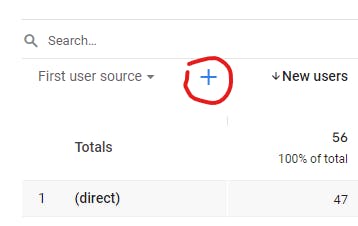Secondary Dimension in Google Analytics: Best Practices and Tips
Secondary Dimension in Google Analytics: Best Practices and Tips
Blog Article
Take Full Advantage Of Coverage Precision With Second Measurement in Google Analytics
Recognizing exactly how to make the most of reporting accuracy with second dimensions in Google Analytics can dramatically improve the depth of understandings obtained from information evaluation. By incorporating additional measurements tactically, marketing experts can uncover hidden patterns and correlations that may not be instantly evident when analyzing main metrics alone.
Comprehending Secondary Dimensions in Google Analytics
To boost information analysis and gain deeper insights right into customer actions, understanding additional dimensions in Google Analytics is essential. Second dimensions enable individuals to segment and further dissect information beyond the main dimension chosen. By incorporating secondary dimensions, experts can refine their reports to disclose more detailed info about customer interactions on a website. For circumstances, while the main measurement may present the overall variety of web page sights, adding a secondary measurement such as 'source/medium' can supply insights right into where the traffic stemmed from. This additional layer of info allows marketers to analyze the efficiency of different advertising and marketing projects or networks in driving web traffic to the web site.
Moreover, recognizing second measurements is crucial for producing a lot more customized reports tailored to specific service goals. By selecting the appropriate mix of primary and second measurements, experts can reveal patterns, patterns, and correlations that might otherwise remain surprise. This nuanced approach to information evaluation empowers organizations to make educated decisions based on an extensive understanding of individual habits across different measurements.

Just How to Use Additional Measurements
When leveraging additional measurements in Google Analytics, the useful application entails selecting particular information specifications to further refine understandings past the primary measurement's scope. To apply additional dimensions properly, begin by accessing the report or dataset where you want to dig deeper into the data. Remember that additional measurements assist provide context and granularity to your primary measurement information, enabling you to remove more workable and purposeful insights from your Google Analytics reports.
Leveraging Second Dimensions for Insights
Utilizing additional measurements in Google Analytics permits a much more extensive evaluation of data, providing important insights past the primary measurement's range. By leveraging additional measurements, customers can delve much deeper into the efficiency metrics of their website or app, revealing hidden patterns and patterns that might not be instantly obvious when just considering primary dimensions.
One key benefit of using secondary dimensions is the capability to segment and filter data extra precisely. This can help marketing professionals and experts better comprehend the behavior of certain user sections, such as new site visitors versus returning visitors, or traffic coming from different geographic areas.
In addition, secondary measurements allow customers to compare and contrast numerous information points within the very same report, offering a more holistic view of efficiency (Secondary Dimension in Google Analytics). For instance, combining the main dimension of landing pages with additional dimensions like tools or demographics can reveal which pages are see here now most effective in engaging customers on various devices or from various market groups.
Basically, leveraging secondary dimensions in Google Analytics equips users to look at this now remove richer insights from their information, resulting in even more educated decision-making and eventually, boosted performance.
Best Practices for Second Dimensions
When analyzing information in Google Analytics, incorporating additional dimensions efficiently enhances the depth of insights originated from the main metrics. To make the most out of second measurements, it is vital to stick to ideal techniques that make certain purposeful and exact coverage. It is crucial to pick secondary dimensions that line up with the key statistics you are evaluating. Picking appropriate secondary measurements helps in providing context and a more clear understanding of the data being checked out.
Additionally, it is suggested to restrict the variety of secondary dimensions used in a single report to avoid overwhelming the evaluation with excessive information. Concentrating on a few crucial secondary dimensions at a time can cause even more workable and concentrated understandings. Furthermore, think about explore various combinations of key and secondary dimensions to discover special trends and patterns that might not appear when checking out the data in isolation.
Advanced Evaluation Strategies With Secondary Dimensions
Discovering elaborate data relationships through the calculated application of second measurements can unveil nuanced understandings that elevate the deepness of evaluation in Google Analytics. By incorporating secondary dimensions with main information sets, innovative evaluation methods can be used to draw out beneficial information.
In addition, additional measurements can boost the evaluation of conversion paths by providing additional context. Recognizing the various touchpoints an individual communicates with before transforming can be crucial in maximizing the client journey - Secondary Dimension in Google Analytics. By utilizing secondary measurements to look into specifics such as traffic sources or devices utilized, marketing experts can tailor methods to target high-converting networks properly
Final Thought

To enhance data analysis and gain deeper insights into user actions, understanding additional dimensions in Google Analytics is necessary - Secondary Dimension in Google Analytics. Additional dimensions enable users to sector and better study data beyond the key measurement picked. While the key dimension may show the complete number of web page sights, including a secondary measurement such as 'source/medium' can supply insights right into where the traffic originated from.When leveraging secondary measurements in Google Analytics, the useful application involves choosing specific information specifications to further fine-tune understandings past the key measurement's extent. Keep in mind that secondary measurements help provide context and granularity to your key measurement data, allowing you to draw out more workable and significant insights from your Google Analytics reports
Report this page